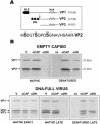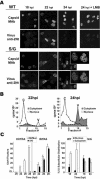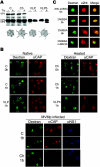Nuclear export of the nonenveloped parvovirus virion is directed by an unordered protein signal exposed on the capsid surface
- PMID: 15367635
- PMCID: PMC516424
- DOI: 10.1128/JVI.78.19.10685-10694.2004
Nuclear export of the nonenveloped parvovirus virion is directed by an unordered protein signal exposed on the capsid surface
Abstract
It is uncertain whether nonenveloped karyophilic virus particles may actively traffic from the nucleus outward. The unordered amino-terminal domain of the VP2 major structural protein (2Nt) of the icosahedral parvovirus minute virus of mice (MVM) is internal in empty capsids, but it is exposed outside of the shell through the fivefold axis of symmetry in virions with an encapsidated single-stranded DNA genome, as well as in empty capsids subjected to a heat-induced structural transition. In productive infections of transformed and normal fibroblasts, mature MVM virions were found to efficiently exit from the nucleus prior to cell lysis, in contrast to the extended nuclear accumulation of empty capsids. Newly formed mutant viruses lacking the three phosphorylated serine residues of 2Nt were hampered in their exit from the human transformed NB324K nucleus, in correspondence with the capacity of 2Nt to drive microinjected phosphorylated heated capsids out of the nucleus. However, in normal mouse A9 fibroblasts, in which the MVM capsid was phosphorylated at similar sites but with a much lower rate, the nuclear exit of virions and microinjected capsids harboring exposed 2Nt required the infection process and was highly sensitive to inhibition of the exportin CRM1 in the absence of a demonstrable interaction. Thus, the MVM virion exits the nucleus by accessing nonconventional export pathways relying on cell physiology that can be intensified by infection but in which the exposure of 2Nt remains essential for transport. The flexible 2Nt nuclear transport signal may illustrate a common structural solution used by nonenveloped spherical viruses to propagate in undamaged host tissues.
Figures







Similar articles
-
Essential role of the unordered VP2 n-terminal domain of the parvovirus MVM capsid in nuclear assembly and endosomal enlargement of the virion fivefold channel for cell entry.Virology. 2012 Oct 10;432(1):45-56. doi: 10.1016/j.virol.2012.05.025. Epub 2012 Jun 23. Virology. 2012. PMID: 22727830
-
A slender tract of glycine residues is required for translocation of the VP2 protein N-terminal domain through the parvovirus MVM capsid channel to initiate infection.Biochem J. 2013 Oct 1;455(1):87-94. doi: 10.1042/BJ20130503. Biochem J. 2013. PMID: 23875612
-
Late Maturation Steps Preceding Selective Nuclear Export and Egress of Progeny Parvovirus.J Virol. 2016 May 12;90(11):5462-74. doi: 10.1128/JVI.02967-15. Print 2016 Jun 1. J Virol. 2016. PMID: 27009963 Free PMC article.
-
Nuclear import and export of viruses and virus genomes.Virology. 1998 Jun 20;246(1):1-23. doi: 10.1006/viro.1998.9165. Virology. 1998. PMID: 9656989 Review.
-
Protoparvovirus Knocking at the Nuclear Door.Viruses. 2017 Oct 2;9(10):286. doi: 10.3390/v9100286. Viruses. 2017. PMID: 28974036 Free PMC article. Review.
Cited by
-
Nuclear entry and egress of parvoviruses.Mol Microbiol. 2022 Oct;118(4):295-308. doi: 10.1111/mmi.14974. Epub 2022 Aug 24. Mol Microbiol. 2022. PMID: 35974704 Free PMC article. Review.
-
Distinct host cell fates for human malignant melanoma targeted by oncolytic rodent parvoviruses.Virology. 2013 Nov;446(1-2):37-48. doi: 10.1016/j.virol.2013.07.013. Epub 2013 Aug 9. Virology. 2013. PMID: 24074565 Free PMC article.
-
Parvovirus particles and movement in the cellular cytoplasm and effects of the cytoskeleton.Virology. 2014 May;456-457:342-52. doi: 10.1016/j.virol.2014.04.003. Epub 2014 Apr 25. Virology. 2014. PMID: 24889253 Free PMC article.
-
Concepts to Reveal Parvovirus-Nucleus Interactions.Viruses. 2021 Jul 5;13(7):1306. doi: 10.3390/v13071306. Viruses. 2021. PMID: 34372512 Free PMC article. Review.
-
DNA-mediated anisotropic mechanical reinforcement of a virus.Proc Natl Acad Sci U S A. 2006 Sep 12;103(37):13706-11. doi: 10.1073/pnas.0601881103. Epub 2006 Aug 30. Proc Natl Acad Sci U S A. 2006. PMID: 16945903 Free PMC article.
References
-
- Agbandje-McKenna, M., A. LLamas-Saiz, F. Wang, P. Tattersall, and M. G. Rossmann. 1998. Functional implications of the structure of the murine parvovirus minute virus of mice. Structure 6:1369-1381. - PubMed
-
- Boyle, W. J., P. van der Geer, and T. Hunter. 1991. Phosphopeptide mapping and phosphoamino acid analysis by two-dimensional separation on thin-layer cellulose plates. Methods Enzymol. 201:110-149. - PubMed
-
- Brown, V. M., E. Y. Krynetski, N. F. Krynetskaia, D. Grieger, S. T. Mukatira, K. G. Murti, C. A. Slaughter, H.-W. Park, and W. E. Evans. 2004. A novel crm1-mediated nuclear export signal governs nuclear accumulation of glyceraldehyde-3-phosphate dehydrogenase following genotoxic stress. J. Biol. Chem. 279:5984-5992. - PubMed
-
- Brownstein, D. G., A. L. Smith, R. O. Jacoby, E. A. Johnson, G. Hansen, and P. Tattersall. 1991. Pathogenesis of infection with a virulent allotropic variant of minute virus of mice and regulation by host genotype. Lab. Investig. 65:357-363. - PubMed
Publication types
MeSH terms
Substances
LinkOut - more resources
Full Text Sources
Other Literature Sources

